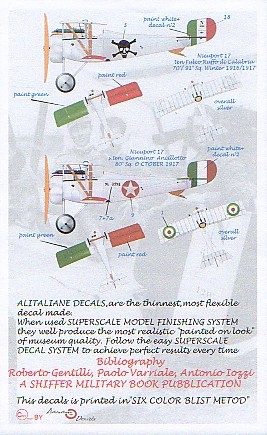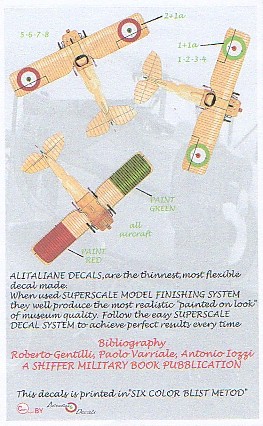|
Alitaliane Decals
Italian Spad VII Pt.1
Italian Nieuport 17 Pt.1
Italian Hanriot HD.1 Pt.1

1/72 & 1/48 scale
S u m m a r y
|
| Catalogue
Number, Description and Scale: |
Alitaliane Decals: 1/72
and 1/48 scale - Italian Spad VII (part 1), Italian Nieuport 17
(part 1), Italian Hanriot HD.1 (part 1) |
| Contents and Media: |
Double-sided full colour
letter-sized instructions plus notes sheet; 1 x full-size decal
sheet |
| Price: |
1/72 scale decals 10 Euro each
1/48 scale decals 12 Euro each from Misterkit website |
| Review Type: |
FirstLook |
| Advantages: |
Perfect register, thin yet
strong carrier film, often neglected subjects |
| Disadvantages: |
Minor slip-up on Hanriot
sheet. |
| Recommendation: |
Recommended |
Reviewed by Rob Baumgartner

HyperScale is proudly supported by Squadron.com
Decals for Italian
aces are not exactly in abundance so it is with great pleasure to
see that Alitaliane are willing to fill the gap.
Three sheets are offered,
one each for the Nieuport 17, Spad VII, and Hanriot HD1.
The sheets are produced in
both 1/72nd scale and 1/48th, with the only
difference being additional roundels, fin stripes and generic
stencils in the smaller scale.
Where white is needed for a
decal, this has been printed separately and follows the “sandwich”
method of application.
Printing has been done on
Inkjet/Clear waterslide decal paper so the modeller will have to cut
around each image to free it from the one-piece carrier film.
There was no problem at all
with registration on any of the sheets. The carrier film proved to
be both thin and flexible when a test item was put through its
paces.
Nieuport 17 (Part 1)

A massive 10 subjects are
catered for with this release.
a)
 Nieuport
17, N 3139 flown by ten. Fulco Ruffo di Calabria of 70/90
Squadriglia, 1917. Nieuport
17, N 3139 flown by ten. Fulco Ruffo di Calabria of 70/90
Squadriglia, 1917.
This aircraft
sported one of the many variations of the “skull and crossbones”
that Ruffo used on his aircraft. It is believed that when this
aircraft arrived from France, the roundels on the top wing were
over painted without the remarking of Italian replacements.
On the 28th
February 1917, Ruffo used this aircraft to shoot down a two
seater from Flik 34, which was involved in a photoreconnaissance
mission.
b) Nieuport 17, Ni 3592 flown by s.ten.
Giovanni Ancillotto of 80 Squadriglia, 1917.
This is one of
the Italian built aircraft and wears the 80 Squadriglia star
painted over the fuselage roundel.
Ancillotto
ended the war with 11 confirmed victories.
c) Nieuport 17, Ni 2614 flown by cap.
Francesco Baracca of 70/91 Squadriglia, 1917.
Baracca
received the Squadriglia’s first French produced Nieuport 17,
and soon decorated it with the famous prancing horse, in
remembrance of his cavalry unit.
Being a French
built machine, it would retain the serial number and data from
that country on its rudder.
He died 19 June 1918 with 34 enemy aircraft
to his credit.
d) Nieuport 17,
Ni 2142 flown by cpr. Attilio Imolesi of 79 Squadriglia,
1917.
It is thought
that Imolesi scored his first victory in this aircraft, which
was marked with a horseshoe for good luck. If he was flying Ni
2142 on 26 April 1917, then it was believed to have been armed
with both a Vickers and Lewis machine gun.
e) Nieuport 17,
flown by s.ten. Flavio Torello Baracchini of 81 Squadriglia,
1917.
Baracchini marked this machine with his
personal emblem of a black shield on the fuselage.
Baracchini finished the war with 31 claimed
victories of which 21 were confirmed.
f) Nieuport 17, flown by
serg. Cosimo Rizzotto of 77 Squadriglia, 1917.
Rizzotto was an
ace that that had 6 of his 7 claimed victories confirmed. The
red heart painted on the fuselage side was the emblem of the
77 Squadriglia.
Rizzotto
survived the war and died in 1963.
g) Nieuport 17, Ni 2614
flown by serg. Guido Nardini of 78 Squadriglia, 1917.
Nardini was
credited with 6 confirmed victories out of his total of 11
claims. His aircraft wore what is thought to be a red
pennant.
h) Nieuport 17, Ni 2614
flown by maresc. Ernesto Cabruna of 80 Squadriglia, 1917.
Only the red
unit star is seen on the fuselage of this French built Nieuport.
The shortage of Vickers guns at the time meant that this
aircraft was “only” armed with an over wing Lewis gun. Cabruna’s
final score would be 8 confirmed victories from a total of 9
claims.
i) Nieuport 17, Ni 2614
flown by serg. Antonio Reali of 79 Squadriglia, 1917.
The striking
marking on the side of the aircraft was that of a “fez”. This is
a soft cloth cap that was worn by the Bersaglieri troops. Reali
was an ace with 11 confirmed victories.
j) Nieuport 17, Ni 2614 flown by s.ten.
Carlo “Frances” Lombardi of 77 Squadriglia, 1917.
When the Macchi
built Nieuport 17 was supplied to 77 Squadriglia, the unit badge
of a red heart was applied over the position occupied by the
fuselage roundel. To cover the roundel, a white circular
background was used.
Click the thumbnails below to view larger
images:
SPAD VII (part 1)

Eight aircraft are supplied
in this sheet.
a)
 Spad
VII, S.4691 flown by s.ten. Ferruccio Ranza of 91 Squadriglia,
1917. Spad
VII, S.4691 flown by s.ten. Ferruccio Ranza of 91 Squadriglia,
1917.
The owl was Ranza’s personal insignia. The
lower part is conjecture as no photographic evidence is known
showing the full image.
b)
Spad VII, S.4695 flown by ten. Bartolomeo Constantini
of 91 Squadriglia, 1917.
Constantini’s emblem was a modest black
pennant. He scored 6 victories and after the war became a
successful racing car driver.
c)
Spad VII, S.4699 flown by ten. Luigi Sabelli of 91
Squadriglia, 1917
Sabelli scored five victories before being
shot down in this aircraft on 25 October 1917.
d)
Spad VII, S.1544/4707 flown by ten. Giuliano Parvis of
91 Squadriglia, 1917.
There are two serial numbers on the rudder of
this aircraft. It is probably a replacement where instead of
scrapping off the old 1544, the new 4707 was written underneath.
e)
Spad VII, flown by ten. col. Pier Ruggero Piccio of 91
Squadriglia, 1917.
Piccio had 24 confirmed victories out of a
total of 24 claimed. The Spad depicted is speculative based on a
single photo of Piccio in the cockpit. It would appear that
there may have been a personal marking also carried but it is
unknown at this time. The griffon was the unit insignia of 91
Squadriglia.
f)
Spad VII, flown by cap. Fulco Ruffo di Calabria of 91
Squadriglia, 1917.
This 20-victory ace scored a treble on 25
October 1918 in a Spad VII but it is not known in which one. He
used a number of different Spad aircraft, usually because it was
not uncommon for Russo to return from combat with much battle
damage.
g)
Spad VII, flown by s.ten. Carlo “Frances” Lombardi of
77 Squadriglia, 1917.
In common with
most of the aircraft of 77 Squadriglia, there was no
personal marking on the fuselage sides. Here we see the
red heart of the unit applied over the painted out roundel.
h) Spad VII, flown by ten. Ferruccio Ranza of 91
Squadriglia, 1917.
Ranza adopted the
ladder insignia after the death of his friend Sabelli. It was the
latter’s personal emblem and after Sabelli’s death, Ranza decided to
use it as a sign of remembrance.
Click the thumbnails below to view larger
images:
Hanriot HD.1 (Part 1)

There are four aircraft
represented on this sheet.
a)
Hanriot HD.1, Hd 18-6614, flown by serg. Guido Nardini
of 78 Squadriglia, 1917.
Both French and Italian numbering appears on
this striking aircraft. The devil insignia was painted over the
fuselage roundel, which bore a red outer circle. Thus it is
logical to expect the upper wing roundel to be finished in the
same way. Only green outer-banded roundels are supplied so the
modeller will have to look elsewhere for these.
b)
Hanriot HD.1, Hd 21-6647, flown by ten. Mario Fucini
of 76 Squadriglia, 1917.
This is another machine that Italy received
as one of its batch of early arrivals from France. If building
this aircraft or indeed any Hanriot from 78 Squadriglia, check
the modifications that were made to the cowling. Chances are you
will have to open up additional holes.
c)
Hanriot HD.1, Hd 515, flown by Flavio Torello Baracchini of
76 Squadriglia, 1918.
Notice that this aircraft has a rudder with a
red instead of a green leading edge. There is a theory that the
French misinterpreted the Italian instructions when it came to
painting these items when the Italians switched to green outer
roundel circles. The order of the four playing card aces was
“handed” as photos of 515 clearly show but sadly those on the
decal sheet are all in the same sequence. Modellers will be in
for some deft touching up for those on the starboard side when
if they try to change the order of the supplied items.
d)
Hanriot HD.1, flown by cap. Giulio Lega of 76
Squadriglia, 1918.
Lega had the collar tabs of his unit
“Grantatieri di Sardegna” as his personal emblem. Inside this
was a grenade with a propeller superimposed on it. As was unit
practice, this most likely appeared on each side of the
tailplane so smaller versions are supplied for this purpose.
Click the
thumbnails below to view larger images:
If you want to model an
aircraft in a scheme you don’t see very often, look no further.
The manufacturers have
chosen well with a colourful array of aircraft and an interesting
selection of pilots.
With many of the aces
appearing on more than one sheet, it is a perfect opportunity to
build a series of aircraft types relating to your favourite flyer.
This is a great collection
of subjects that will inspire many, and the good news is that each
of these sheets is only “Part 1”.
Recommended
Review Text Copyright © 2004 by
Robert Baumgartner
Page Created 24 November, 2004
Last updated
23 November, 2004
Back to
HyperScale Main Page |
Home | What's
New | Features
| Gallery |
Reviews | Reference
| Forum
| Search